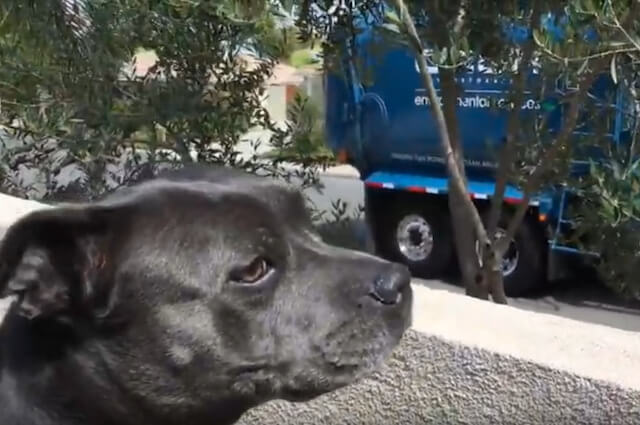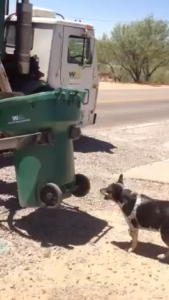How to Handle Your Dog’s Fear of Garbage Trucks
Many dogs dread the sights and sounds that come with the weekly trash pickup, and for a lot of dogs, garbage trucks can be downright scary.

Behavior modification and training can greatly alter how your dog feels about garbage trucks. We’ll take a look at training for both indoors and outdoors and how to get your dog to relax around garbage trucks.
Why Are Garbage Trucks So Scary?
Fear of garbage trucks is usually not the only loud truck a dog is fearful of. In fact, it usually also involves many other kinds of large trucks or buses, and the main reason has to due with the vehicle’s size and volume of noise.
These trucks are just loud. They start and stop many times usually with a squeal from air brakes when stopping and a growling engine when they start again. These noises, combined with the sheer size of a garbage truck, are overwhelming for many dogs.
Some truck fears also relate to bad experiences such as being hit by a large vehicle, being startled by a truck on a walk, etc. These bad experiences then shape a generalized fear for the dog of all garbage trucks or large vehicles.
Indoor fears and outdoor fears are usually a little different both in manifestation and also in treatment.
When your dog hears the garbage truck while indoors, their fear is solely noise based, and because it is brief, usually these dogs will experience:
- Whining
- Barking
- Pacing
- Running around
- Elevated heart rate
- Piloerection (or their hackles/hair on their back stands up)
Garbage truck fears are greatly enhanced for most dogs outdoors, especially on walks, where they see the garbage truck multiple times per walk. In these cases, depending on the severity of the fears, a dog may experience:
Same symptoms as above with:
- Lunging
- Growling
- Hiding or diverting behind owner
- Sweating
- Trembling
- Attempting to climb on owner
- Urination or defecation
- Loss of attention; inability to focus
It is very common to see fear of garbage trucks be demonstrated by the classic responses of fight, flight, freeze, or submission. Some dogs become aggressive in an attempt to ‘run-off’ the scary garbage truck. Because the truck does move away, they think it is their bravado that made it leave.
Other dogs will attempt to flee and pull drastically on the leash; while others will stop stone-cold in place and no amount of cajoling or pulling will get the dog to move until it is ready.
Ideally, through behavior modification and training, your dog will learn to submit and move though its fear of garbage trucks.
How to Modify Your Dog’s Behavior with Garbage Trucks
For when your dog is indoors on the garbage truck’s route, your best course of action is to be prepared for its arrival. Most garbage trucks do rounds on a fairly reliable time schedule, so you will get a feel for when the truck might arrive.
Try giving your dog Bach’s Rescue Remedy 30 minutes prior. Rescue Remedy is an all-natural calmative with no adverse or lasting effects. It simply helps your dog to relax.
Turn on the television or radio to drown out the sounds of the garbage truck and try to schedule fun alternate activities for your dog such as playtime, pre-stuffed Kong toys, or training activities. The goal is for your dog to be focused on something else when the garbage truck comes down the road.

Outside is always a little trickier and will take more work and patience on your part. You must be willing to invest the time and training. Here are some of the things you will want to do to help change your dog’s fear of garbage trucks while on walks:
1. Figure out what food items your dog absolutely loves. Because we are working through fear, you will really want items that are super-wonderful, and people food like hot dog bits, cooked chicken cubes, cheese, etc usually work best. Have a lot of them!
2. If you have a large, powerful dog or one that is currently using aggression with his garbage truck fear, you should probably walk your dog using a head halter to give you more control.
3. Determine how far away from a garbage truck your dog begins to get nervous. This will be the threshold to work around. We don’t want the dog to experience full-on fear because then he will only be reacting. Instead, we want to slowly increase his comfort levels.
4. Keep initial training sessions short. You don’t want to overstress him.
5. Position yourself at your dog’s threshold distance from garbage trucks. It might be 15 feet away, across the road, etc.
6. Now, you will practice training and focus techniques so that your dog can see the trucks, hear them a bit, but he’s not in a full-blown fear stage. You should practice skills like ‘Watch Me,’ ‘Come,’ along with using things like ‘Sit’ and ‘Down.’
7. Keep your reward level high! Lots of goodies combined with the training teach him to focus on you and to trust you.
8. Allow him to see the garbage trucks but not to focus on them. If he focuses too much on the trucks, he will have time to build his fear. Instead, allow seeing the trucks but break up too much focus with redirecting his focus onto you with ‘Watch Me’ and other training skills and the treats.
9. Slowly over time, you will see that his threshold is changing, and you will be able to work closer and closer to the garbage trucks.
10. Until then, keep working on your focus training and don’t put him in positions of having to walk right by a garbage truck. Instead, cross the street to give more personal space.
Will his garbage truck fears change over night? No, they won’t, but with patience, consistency, and hard work, they will change. He will learn to re-associate garbage trucks with rewards, training, and he will learn that he is okay. Instead of fighting, fleeing, or freezing, he will learn to submit to the process in a good way. Just make sure to never get angry or frustrated with him, or it will only serve to increase his garbage truck fears and reactions.
